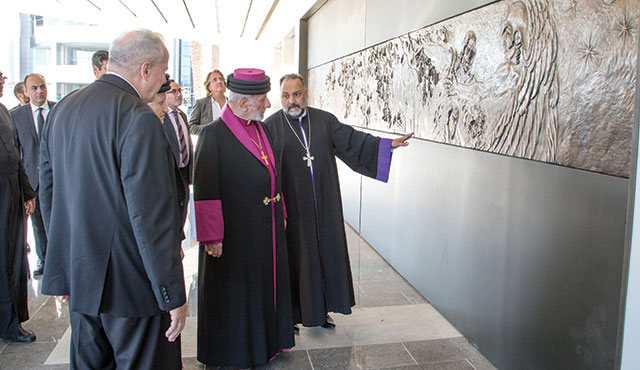The visitor to Christ Cathedral gazed in wonder at the interior of the church, the afternoon light filtering through the 10,000-plus quatrefoils above him.
“By the grace of God, we are all assembled here together,” he said in his native tongue, Syriac, a dialect of Eastern Aramaic, the language spoken by Christ. “May God’s blessings be upon you and this house.”
This was no ordinary visitor, but rather His Holiness Mar Gewargis III Sliwa, is the Catholicos-Patriarch of the Assyrian Church of the East – the pope, in effect, of one of the major branches of Christianity, whose numbers have been decimated due to conflict in the Middle East but who still total some 450,000 today.
Gewargis III and his entourage, as well as his high-ranking Christ Cathedral tour guides, spoke in hushed tones during his historic visit Tuesday, Sept. 17, since the cathedral officially was closed for ongoing “voicing” of the Hazel Wright organ, in which complete silence is desired.
But the occasion spoke loudly to ongoing efforts between the Assyrian Church of the East and the Catholic Church to someday come into complete communion with each other.
Gewargis III spent about 90 minutes at Christ Cathedral, one of his final stops on a three-month tour of 20 Church of the East parishes throughout the United States before he returned to Iraq.
Gewargis III requested the special visit to Christ Cathedral after spending time at St Paul’s Assyrian Church of the East in Anaheim. Among the members of his entourage was St. Paul’s Pastor Fr. Ashur Elkoury.
For 35 years following the breakout of the Iran-Iraq War in 1980, the episcopal see of the Assyrian Church of the East had been based in Chicago. After Gewargis III, 77, was formally consecrated and enthroned as Catholicos-Patriarch on Sept. 27, 2015, he relocated the see to Erbil, Iraq.
“He did this in order to rebuild his Church, which is in great crisis,” said Fr. John Monestero, a member of the Commission on Ecumenism and Interreligious Affairs for the Diocese of Orange since 1989 who specializes in Orthodox-Catholic Affairs and the Eastern Catholic Churches.
“Even as we speak, there are new threats to all the Christian communities in Iraq as Iranian-backed militias are moving into the void left by ISIS,” Monestero said. “The Patriarch, by moving back into such a dangerous situation, proves himself to be a good shepherd who is not abandoning his flock.”
A FORMAL GREETING
A Diocese of Orange welcoming party assembled in the lobby of the Cultural Center awaiting the arrival of Gewargis III.
“Today is a very exciting day at Christ Cathedral because…the vision that we’ve always had…is to welcome our brothers and sisters from our Church throughout the world,” said Fr. Christopher Smith, episcopal vicar and rector of Christ Cathedral.
“This is a wonderful opportunity, especially on the wings of the (formal dedication of the Christ Cathedral, on July 17, 2019), to have this outreach.”
Fr. Smith and Fr. Monestero were joined by Msgr. Stephen Doktorczyk, vicar general of the Diocese of Orange; Fr. Edward Becker, the diocese’s episcopal vicar for ecumenical and interreligious affairs; Fr. Al Baca, the diocese’s director of evangelization and faith formation; and Bishop Tod Brown, bishop emeritus of Orange.
Before he formally greeted Gewargis III on the third floor of the Cultural Center for a gift exchange and refreshments, Bishop Brown commented on the special visit.
“(This) is a big honor (for) us,” Bishop Brown said. “They (Assyrian Church of the East) have a special relationship with our Church in Rome, so we’re happy to show them our cathedral and our other campus buildings here… It’s just a great chance for us to contribute to the unity of the Church, that one day we will all be one – God willing.”
In November 2018, Gewargis III had an audience with Pope Francis, but complete communion of his Church with Rome remains a work in progress. Most of the Church came back into communion with the Catholic Church starting in 1553 and was given the name “Chaldean.” There is one Chaldean Catholic parish in the Diocese of Orange: St. George, in Santa Ana, headed by Pastor Fr. Lucian Babaka.
Following the tour, they engaged in evening vespers in Aramaic and some English in the Chapel in the Sky, located on the top floor of the Tower of Hope.
“It brings me joy that we are all able to pray together in this house of God,” Gewargis III said. “I will take with me many memories from this visit. It was a blessing.”
The ecumenical chapel boasts panoramic views of Orange County, which did not go unnoticed by Gewargis III.
“We are close to heaven,” he said, provoking light laughter and smiles.

